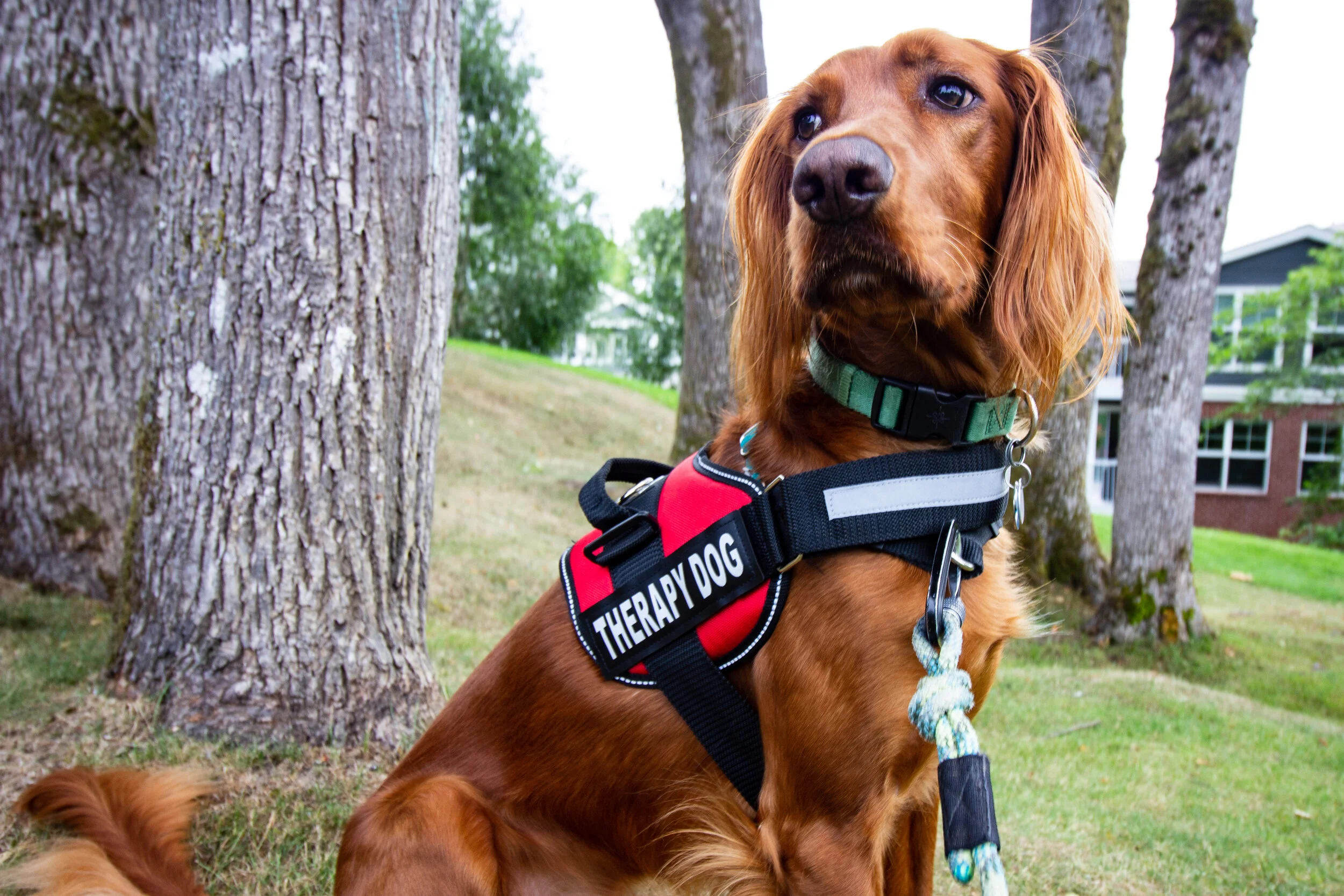Emotional Support Animal Facts
Maddie, my Emotional Support Animal (ESA) on one of our many trips to New York City.
This post may contain affiliate links, which means I may receive a commission, at no extra cost to you, if you make a purchase through a link. This helps me keep the Sick Girl Travels blog running while providing you with high-quality product recommendations and great travel deals. Please see my full disclosure for further information. Thanks for your support!
***Update to the ESA Program as of 2021***
Unfortunately, most airlines have stopped allowing Emotional Support Animals onboard their aircraft. I’m leaving this post up as many people may want to use Emotional Support Animal certification to ensure their animal will be accepted into their apartment complex, hotel, or other space. This post also contains important info on preparing your pet for travel and keeping them safe in the air. While most carriers have stopped accepting ESAs, passengers who formerly flew with their Emotional Support Animal may be able to keep flying with their pet by filing paperwork for them as a psychiatric assistance animal. It is important to check with your air carrier’s Accessibility Desk to determine eligibility.
Contact information for most major carriers’ Accessibility Desks can be found here.
Emotional Support Animals, What You Need To Know…
The popularity of emotional support animals, or ESAs, has skyrocketed in the past few years to the delight of many travelers who legitimately benefit from their service. But sadly, much to the chagrin of others. You’ve probably seen images of these emotional support animals on the news or plastered all over social media. They’re everything from well-behaved dogs and cats to untrained pets, giant peacocks, mini horses, random barnyard animals, and exotic animals. You may be wondering, what are emotional support animals? How does emotional support animal registration work? Which animals qualify to be an ESA? What service do emotional support animals provide? Where can emotional support dogs go? And how the heck did we get to the point where planes are loaded up like a Noah’s Arc with wings?
Well lucky for you, I have answers to these burning questions and much, much more!
Therapy service dog clearly identified by a harness… but what does it mean?
First, let me say I’m a strong believer in the benefit of good Emotional Support Animals. The therapeutic benefit of animals has been well documented in numerous medical studies over the years. They help lower blood pressure, reduce anxiety, alleviate depression, reduce pain, normalize heart rate, increase social interaction, and decrease feelings of loneliness. For someone like me who struggles with severe, chronic pain, depression, anxiety, and blood pressure spikes that have climbed as high as 210/98, my emotional support dog helps keep my mind off of my pain and helps me from having intense panic attacks while stuck mid-flight. My emotional support dog provides a very legitimate service. She’s safer for me than Xanax, and she legitimately loves traveling.
My emotional support animal, Miss Madelyn Pew, flying over San Francisco on United Airlines.
What I do not support is the abuse of the ESA system. What began as a well-intentioned effort to provide assistance to those who need it, has exploded into a business of online doctors writing ESA prescriptions for patients they’ve never even met or even spoken with. Greedy passengers looking to fly cheaply with their pets obtain the necessary emotional support animal paperwork, but don’t bother to train or prepare their animals for the lengthy flight process. This results in animals relieving themselves in planes, biting passengers, airline employees, and other animals on board, causing delays, and generally doing the complete opposite of what a real ESA is supposed to do by increasing the anxiety levels and heart rates of everyone on board.
But this post is for those of you who, like me, believe they can truly benefit from an emotional support animal. I will walk you through the steps of how to obtain the necessary ESA paperwork, where to submit your ESA paperwork before you travel, what training and temperament your pet should have to be an emotional support animal, and what you need to do to prepare your pet for travel.
You may be wondering, what makes me such an authority? Well, I’ve not only flown all over the United States with my ESA, but I’ve also flown multiple rescue animals around the world both in-cabin and in temperature-controlled cargo hold. I’ve now flown over 35 dogs and cats from Beijing, through Moscow, and on to Los Angeles. I’ve had cats escape mid-flight and terrorize Aeroflot flight attendants, I’ve transported puppies in soft side carriers beneath my feet, and I’ve pushed 10 dogs at a time through US customs. Last year alone I flew over 80,000 miles with dogs and cats. I’ve learned a lot about what to do and what not to do in that process.
In this post, I’ll be focusing on in-cabin emotional support animals, but if you have any questions about traveling with pets, please feel free to contact me through the link below. I’ll be happy to answer your questions.
The eight dogs and one cat who flew with me from China to Los Angeles via Moscow to be adopted out by Jelly’s Place in San Francisco. This was my third rescue mission to China.
Waiting for our connecting flight in Moscow. Dog meat trade survivor, Romeo flew with me in cabin from Beijing to Los Angeles, via Moscow on my forth rescue mission.
Service Dog vs Emotional Support Dog
There is a very big difference between service animals and emotional support animals. Service animals are trained and often bred to perform a function or do a job that their owner cannot perform on their own due to physical, intellectual, or emotional disability. They often go through rigorous training programs and it can be highly competitive to acquire one. Service animals may also provide comfort and emotional support to their owners, but first and foremost, they are highly skilled working dogs. They are afforded more protection under the law and are allowed access to almost every public space. Because the requirements for a service animal are much higher than those of an ESA service dog registration is a highly involved process.
According to the Americans With Disabilities Act, (ADA), service dogs are “trained to perform tasks for people with disabilities.” These include seeing eye dogs, dogs that perform hearing functions for the deaf, dogs that pick up objects for their owners with limited dexterity, medical alert dogs, and dogs used to aid those with autism.
To obtain a service dog you need to be diagnosed with a disability, have a specific assistive need, and then apply through a service dog agency. The agency will then work with you to find a dog that suits your particular lifestyle and needs.
Emotional Support Animals are a bit different. ESAs provide therapeutic benefits to people diagnosed with mental, intellectual, or physical disabilities, but they do not perform a specific task. To get an emotional support animal the animal’s owner must be diagnosed with a disability by a doctor or mental health professional and receive the proper paperwork stating what benefits the animal provides. The emotional support dog registration process is considerably easier than that of a service animal.
Emotional support animals are most commonly used to help patients with anxiety, bipolar disorder, chronic pain, depression, eating disorders, insomnia, post-traumatic stress disorder, and/or schizophrenia, but they can be helpful for many other conditions. Instead of applying through an agency and waiting for a match, you may elect to make your own pet an emotional support animal. This is both good and bad. It allows people to travel with their own pet that they already have a strong emotional bond with, BUT it requires zero formal training of the animal. This can lead to passengers flying with animals that don’t respond to commands or exhibit aggressive behavior.
If your dog is aggressive, not potty trained, or doesn’t listen to your commands on the ground, DO NOT take them in the air as an emotional support animal. The barking, nipping, destructive behavior, and inability to stay put will send your anxiety levels skyrocketing. It also makes you liable for any damage your dog causes and puts the entire ESA program in jeopardy for the rest of us. Please don’t try to scam the system or hope Fluffy will miraculously decide to behave just because they’re on an airplane.
Maddie, my ESA in the United Lounge at ORD waiting to board.
How Do I Register My Dog as an Emotional Support Animal?
OK, so you have a disability, you have a dog (or cat) that’s potty trained, isn’t aggressive, and knows basic commands. You love this pet. This pet helps you reduce stress, it shows you love, and you want to fly with them. Now what?
There are a plethora of places claiming to issue Emotional Support Animal letters online. I urge you not to get your emotional support animal letter online. As more and more people abuse the ESA system airlines have begun to crack down on accepting paperwork from these online doctors. Do not risk using an online service. The last thing you want is to miss your flight because the airline marked your paperwork as coming from a scammy doctor. You’ll be out money and time and possibly miss your flight.
To get the proper ESA paperwork you need to visit your primary care physician or mental health provider. Your doctor should be located within the sate you currently reside in.
AVOID ANYONE WHO:
Is offering to issue your emotional support dog certification online
Is out of state or out of the country
Is suspiciously cheap (anything under $120)
Says they will add your animal to an online registry. There is NO online registry. There is a service dog registry, but again ESAs are not service animals. They require paperwork that you must present to the airline or hotel every time you travel. There is no online emotional support animal registry.
If your doctor thinks you are a good candidate for an emotional support animal they will issue you several forms. The paperwork will contain several forms. It’s not just one ESA letter. My doctor’s office issued me individual letters for most US carriers. Each airline has its own form, so make sure to tell your doctor your carrier(s) of choice. Your doctor will also issue you an emotional support dog letter for your landlord or potential landlord. If you’re a renter this is important. It can allow you to rent in otherwise dog-free apartments and spare you a pet deposit.
Under federal law, individuals who have letters validating their need for an ESA are granted two very important rights:
They typically cannot be denied access on a flight with their ESA.
Landlords typically cannot refuse to rent to a person with an ESA due to a no-pets policy. Additionally, ESAs are exempt from any pet security deposit or fees.
Some medical providers will also issue you an emotional support animal ID card with your dog’s photo. This is very cute to have, but nobody will ever ask for it or accept it as proof that your dog is an ESA. Your emotional support letter or letters are your proof. Make sure you carry a hard copy with you whenever you travel with your pet. You may be asked to provide a hard copy at check-in.
Your airline ESA paperwork will contain the following:
A Medical/Mental Health Professional Form - This lists your animal’s type, breed, and weight, as well as the doctor’s recommendation, signature, license number, and contact info.
A Passenger Liability Form - This is to be filled out, initialed, and signed by you the passenger saying you take full responsibility for the safety, well-being, and conduct of your animal. Again, if your pet is a terror at home, it is 100% not going to be any better in the air.
A Veterinary Health Form - This is to be filled out by your vet. It requires your pet come in for an exam and the exam date be noted on the paperwork. It also requires your vet note the date of your pet’s rabies and distemper vaccines and the dates those vaccines are valid until. Your vet must then sign the form and provide their license number and contact info.
The ESA paperwork cost me $160, but it more than pays for itself after just one trip. United Airlines charges $125 each way for a pet to travel in-cabin. That $250 RT allows your pet to travel in an airline-approved carrier underneath the seat in front of you. ESA paperwork will allow your pet to travel outside the carrier by your feet or in your lap so long as they remain in your control and non-disruptive. ESA paperwork is good for one year, so long as your pet’s vaccinations remain up to date. You must renew your ESA paperwork every year and update your vaccination and vet records as necessary.
Please note when buying your ticket that Emotional Support Animals are NOT allowed in emergency exit rows. If you purchase a seat in these rows you will be reassigned at boarding.
Types of Emotional Support Animals
Typically emotional support animals are limited to cats and dogs. Other domesticated animals may be considered on an individual basis. Under the Air Carrier Access Act airlines are never required to accommodate unusual animals such as ferrets, rodents, snakes, and other reptiles, or spiders within the passenger cabin of an airplane. Bottom line, don’t show up with your emotional support peacock hoping to board. You will be denied.
In addition, in 2018 Delta Airlines banned pit bulls and similar breeds from the passenger cabin as emotional support animals after an ESA pit bull bit two employees. Please check with your individual air carrier for their breed restrictions. At the time of this writing, I’m not aware of any other carriers with breed restrictions, but ESA rules are constantly in flux. It’s always worth confirming with your airline.
Maddie waiting to board in Newark, NJ
How Do I Know If My Dog Will Be Okay Flying?
Whenever I fly with my ESA I inevitably hear this question. The short answer is, you don’t know for sure. While you can be assured that a pressure and temperature controlled cabin is perfectly safe for pets, you cannot be sure that your pet will behave. If you are at all uncertain, I recommend starting with a short trial flight. If possible, start flying with your dog while they’re young. I started flying with Maddie when she was just 10 weeks old. Her first flight was a quick trip from Los Angeles to San Francisco. She slept like a baby inside her carrier at my feet the whole way. We then built to longer trips from LA to Chicago and LA to NYC. For the first year of her life, she traveled inside her soft side carrier. That first year I did not register her as an ESA because she was not potty trained and she had not finished her obedience classes. I wanted to make sure she could follow commands and hold her bladder and bowels. You do not want your pet relieving themselves in flight. It’s messy and it makes everyone on board instantly hate you.
When Maddie turned 2 I filed the necessary paperwork making her my ESA. Since then she’s traveled more of this country than most people and she’s helped me conquer my crippling fear of flying on more than one occasion.
Maddie’s first flight as an in cabin pet.
Maddie, my ESA in her soft side carrier waiting for our Lyft to the airport.
Reminder, just because your ESA is allowed to travel outside their carrier on flights, does not mean they will be allowed inside every rideshare or taxi. When we travel we often bring Maddie’s carrier in case we encounter a driver who refuses to let her ride outside of a carrier. The law does not offer ESA protection in taxis and rideshare.
How To Prepare Your Dog for Flying
Before you fly make sure you submit your ESA paperwork to your carrier. I would recommend doing this at least 72 hours in advance. You can do this by contacting the airline’s accessibility desk. Visit my Airline Accessibility Desk page for contact info for most major carriers.
Keep in mind your dog will have to go through TSA screening. While there is no required emotional support dog training, the best ESA dogs and cats have a base level of obedience training. You will need to remove your pet’s leash, harness, and collar, put those through the X-ray machine, then take your dog through the metal detector. I’ve trained Maddie to first wait for me to clear the metal detector. When I give her the command she walks through screening on her own then sits at the end of the conveyor belt where she waits for her harness and leash to come out. If your pet cannot go through security on command, or wait when told, you will need to carry them through screening. If your pet manages to set the metal detector off, they may be required to go through on their own. This is where proper pet training comes in handy.
Maddie waiting for our Christmas flight to NYC in the LAX United Lounge.
A couple of hours before your flight you will want to limit your dog’s water intake. I usually keep her meal before the flight small and carry treats with me for the trip. Inflight I give her ice cubes so she can remain hydrated without getting a full bladder.
Most airports now have a pet relief area. Make sure you take your pet to potty both before you take off and as soon as you land.
How Much Room Will I Have For My ESA?
I’ve seen people travel with all sorts of emotional support animals. With my chronic pain sitting in a cramped area is problematic. I wouldn’t want to travel with an animal much bigger than a french bulldog, but your needs may vary. I’m 5’ 8” and need to be able to move around a bit because of constant cramping and muscle spasms. Flying with a large dog would cause me more pain and anxiety than flying without an ESA.
I’ve put together a few pictures below to illustrate how much space Maddie takes up in economy, economy plus, bulkhead seating, first-class, and fully reclining first-class bed seating. One thing to note with fully reclining bed seating is that you will probably want to carry your pet on your lap and allow them to sleep on top of you. If you place them under your seat, you risk crushing them or tangling their leash in the mechanics. I would also avoid taking an aisle seat if possible as your pet runs the risk of being accidentally kicked or hit with the beverage cart.
NEVER EVER put your pet in the luggage compartment, even if the flight crew requests you do so. This is certain death for your pet. It’s better to be dragged off the plane and settle it later than to put your pet’s life in jeopardy.
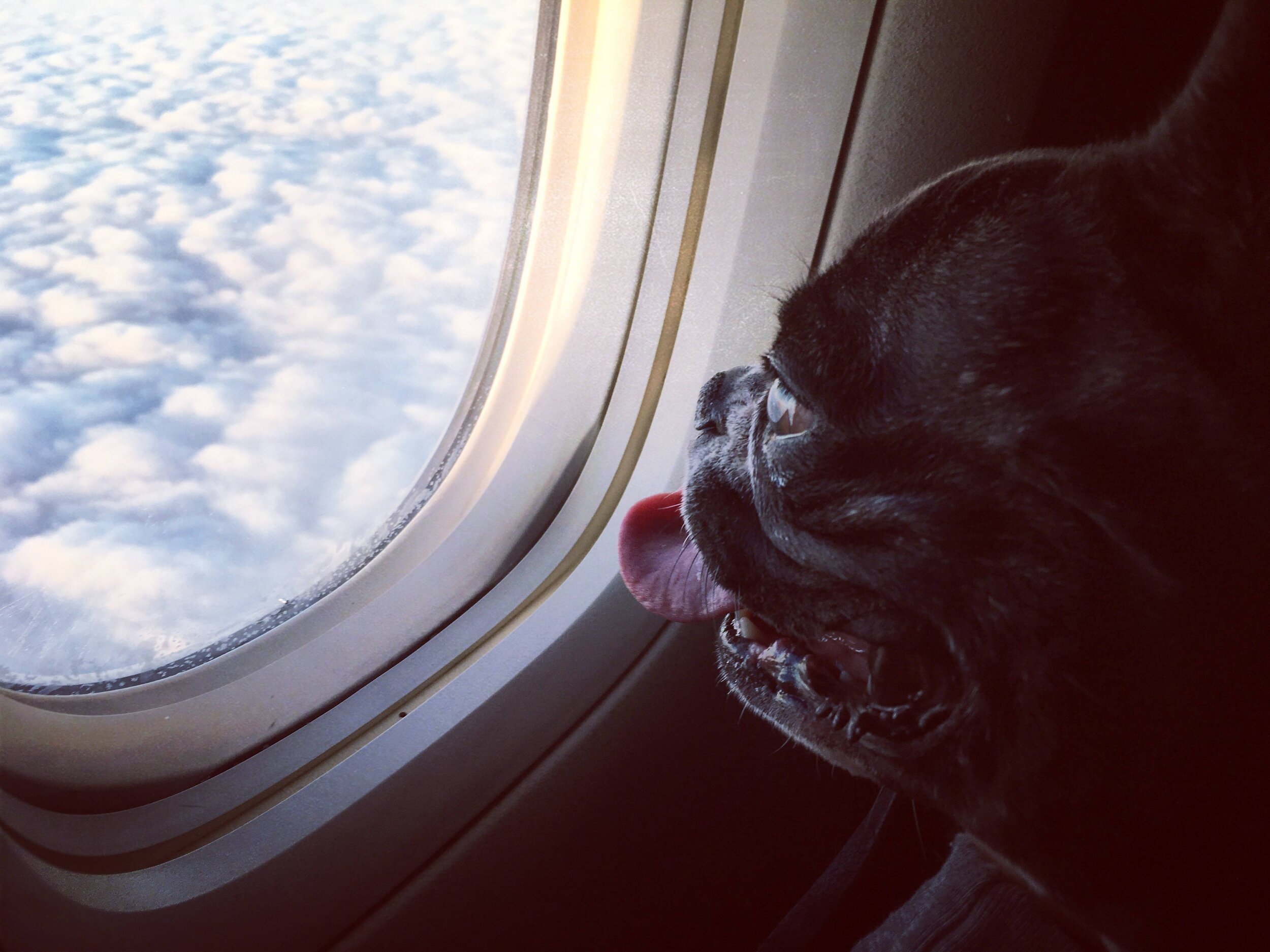
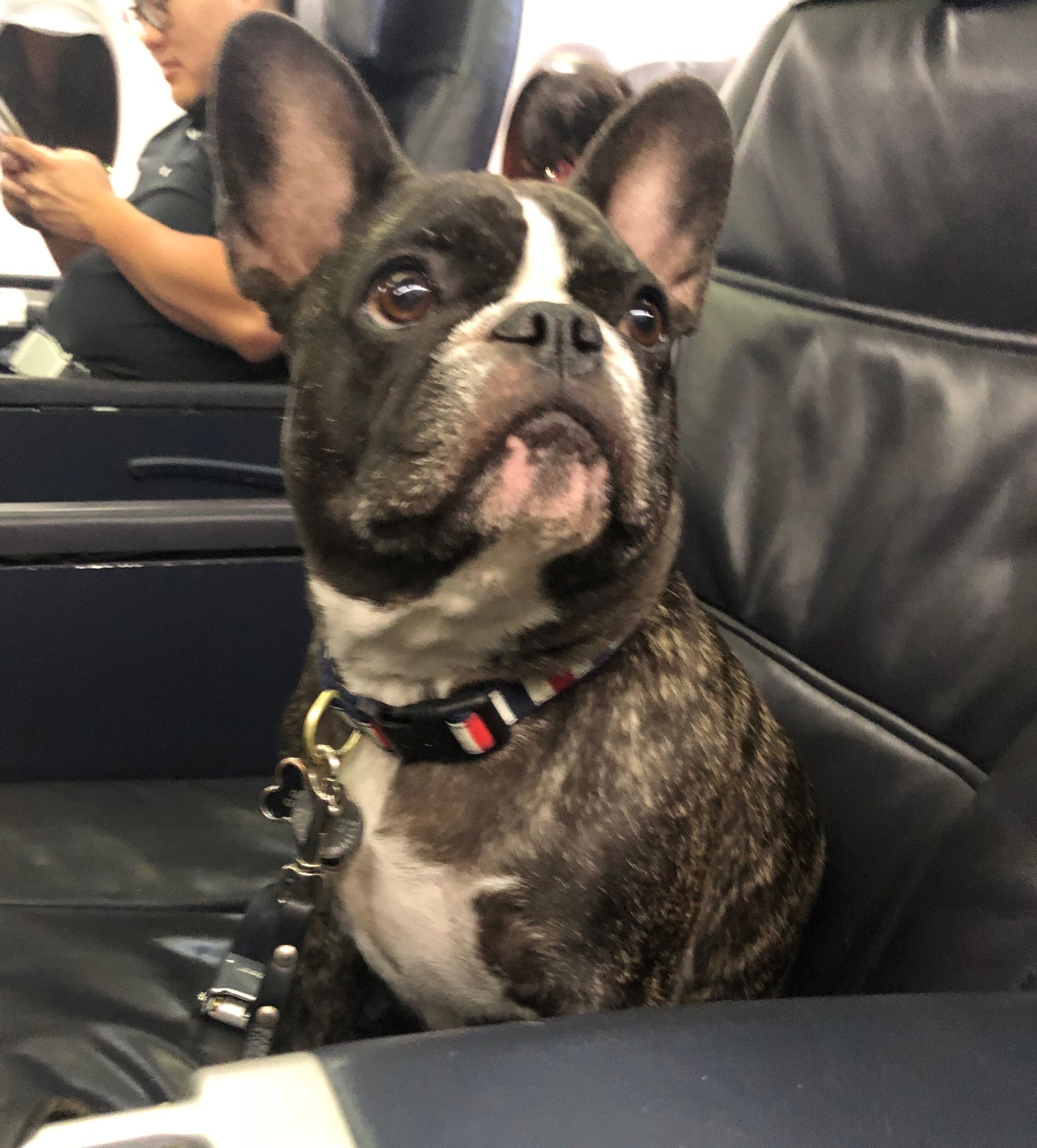
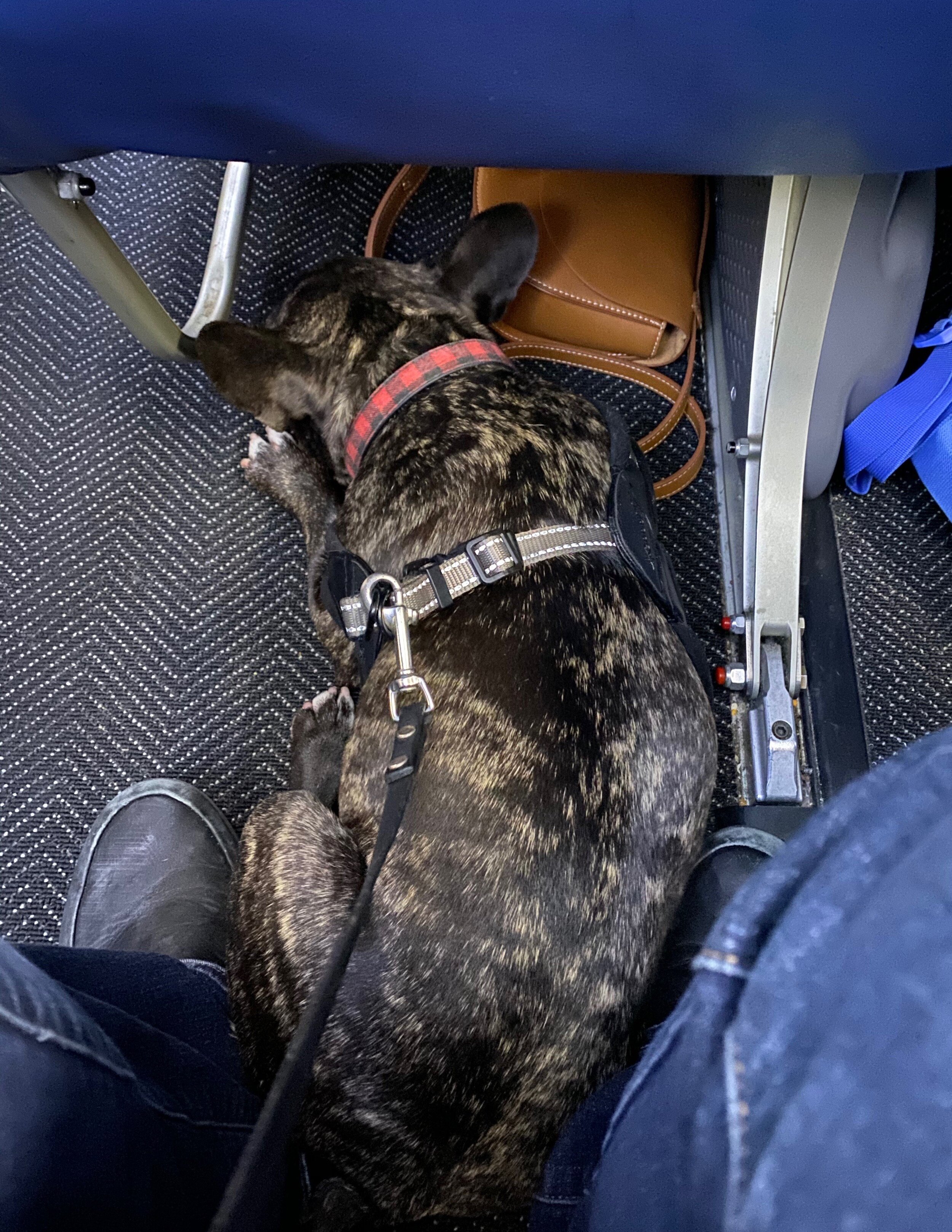
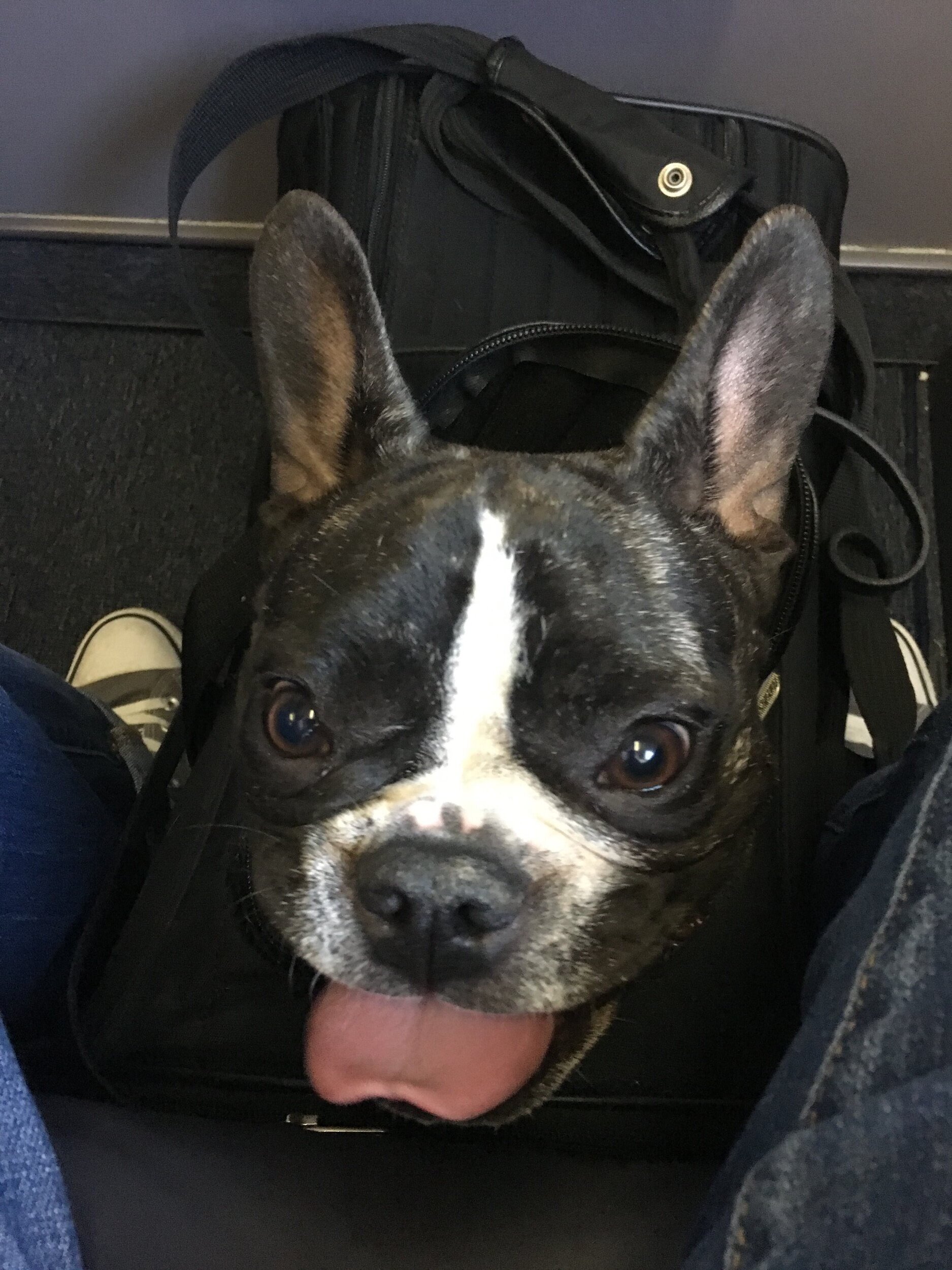
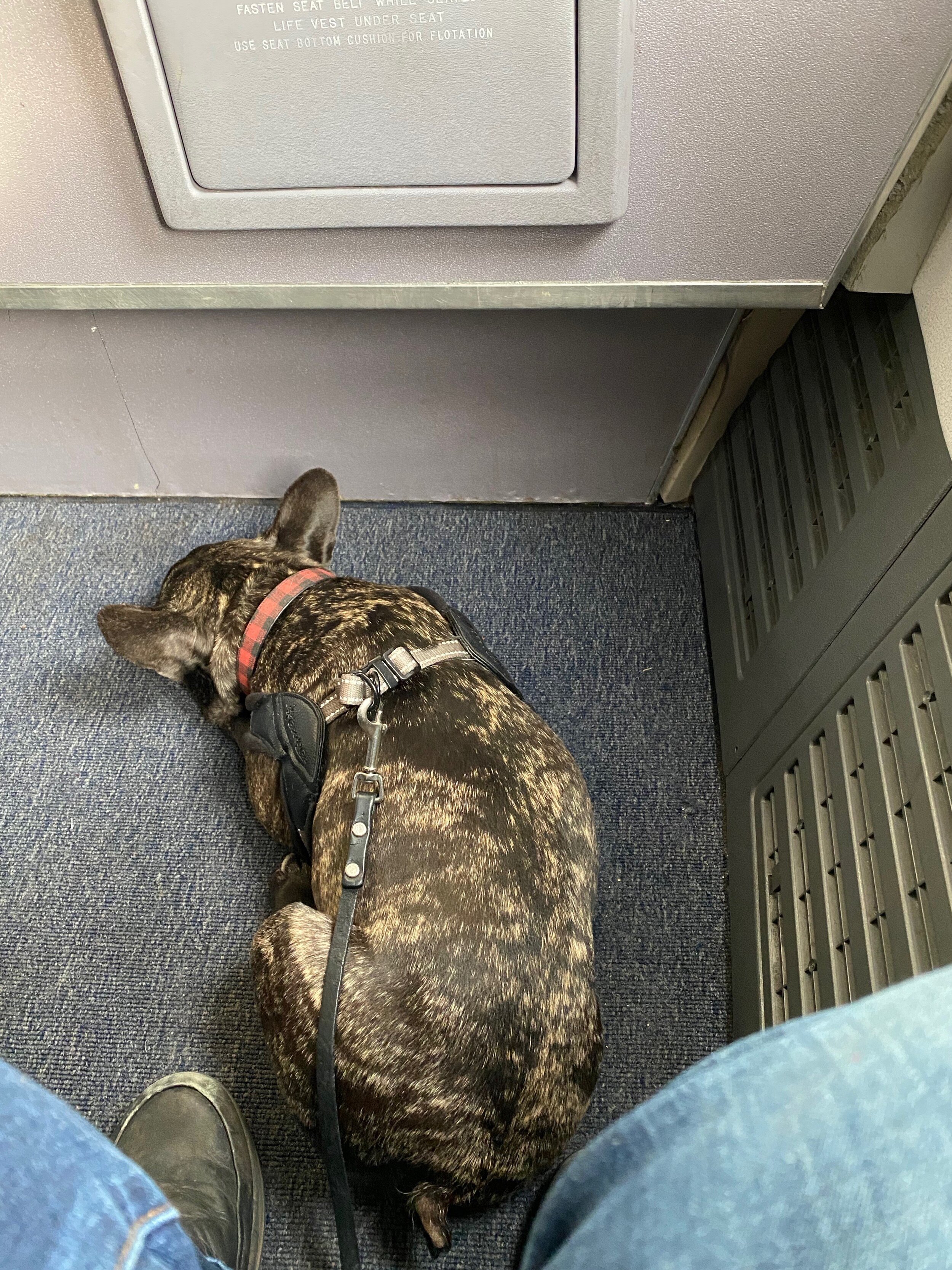
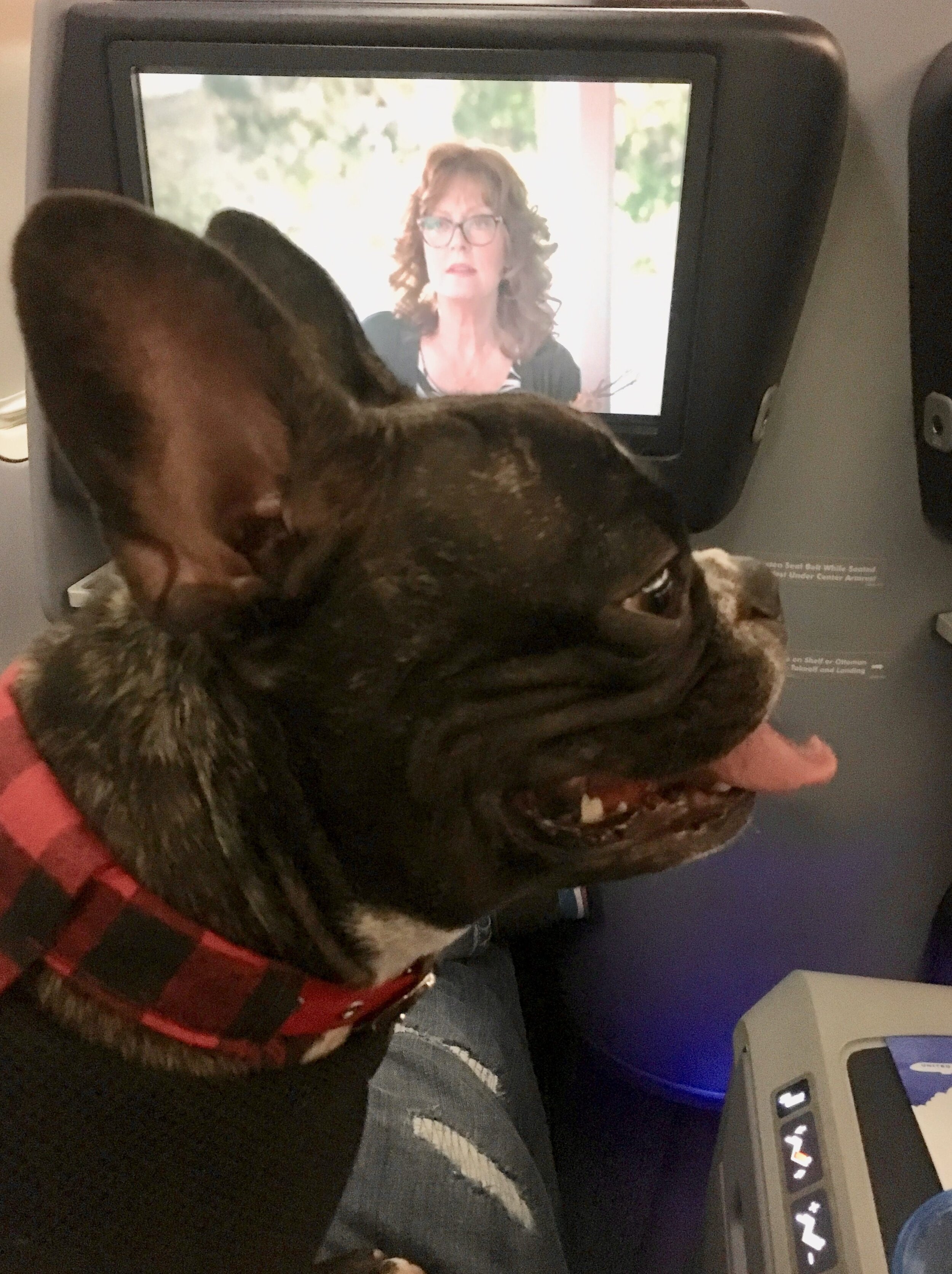
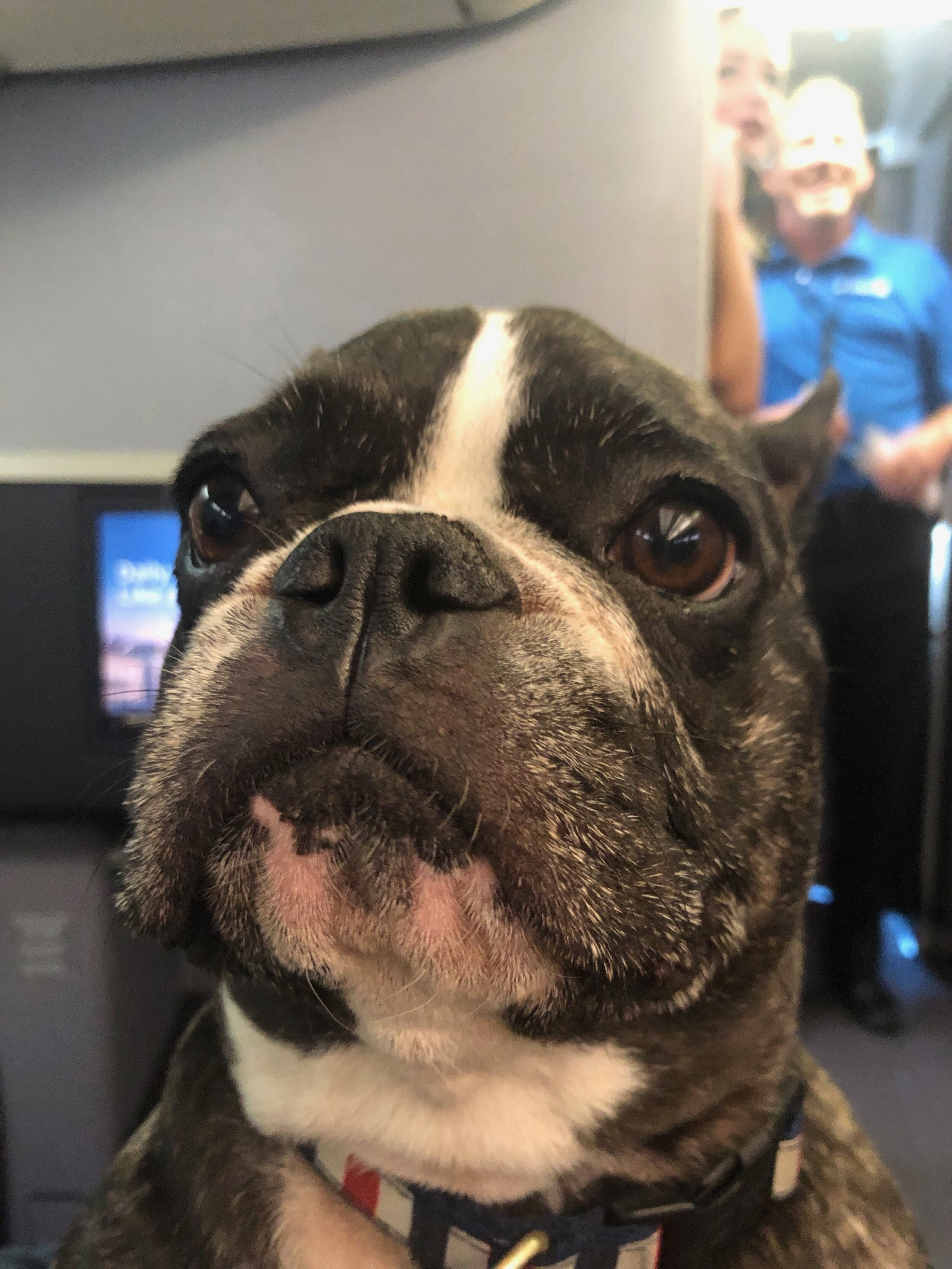
Will My ESA Be Accepted In Hotels?
ESAs are accepted in most hotels. You will need to confirm this before travel and bring your supporting paperwork with you when you travel. Never leave your paperwork at home. Please note there still hotels that will refuse emotional support animals. They are within their legal rights to do so. Also, please note that just because a hotel accepts emotional support animals does not mean you will be allowed to leave them in the room unattended. Aloft Hotels for instance are very dog-friendly, but they do not allow you to leave an animal unattended in your room. Depending on your travel plans this could be problematic. Make sure you confirm the rules with your individual hotel before traveling. Other hotels like Loews provide a full pet menu and allow pets to remain in the room unsupervised.
Maddie enjoying her beach getaway at Loews Santa Monica, CA.
Other Information for Flying with Your Emotional Support Animal:
You’ll see a lot of people buying tags, vests or harnesses labeled “therapy animal” or “emotional support animal.” These are not necessary for your ESA. Moreover, your ESA is NOT a therapy animal. Therapy animals are specially trained animals used in retirement homes, hospitals, medical facilities, schools, and other places for the specific purposes of therapy. They must undergo training and be specially certified with a therapy animal organization. So, save your money and skip the emotional support vest. For more information on therapy dogs visit The Alliance of Therapy Dogs.
There is no identification needed to fly with your emotional support animal other than the paperwork required by the airline. A lot of these vests, harnesses, and tags are sold to people hoping to just slap one on their pet, bring them to public places, and not be questioned. The odds are more likely than not that you will be questioned. With so much abuse of the ESA laws airlines, public transportation, hotels, and businesses are getting wise to people trying to scam the system. Save your money and skip the vest. Just make sure you carry your paperwork.

